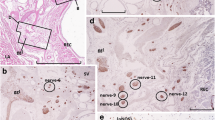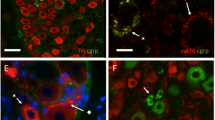Summary
Histological and histochemical techniques have been employed to determine the structure and autonomic innervation of paraganglia located in the human pelvis. In foetal and early postnatal tissues, paraganglia formed rounded cellular masses which were frequently in company with the autonomic nerves and ganglia of the urinary bladder and other pelvic viscera. The constituent cells contained only small amounts of cholinesterase and were unrelated to enzyme positive autonomic nerves; acetylcholinesterase containing nerves were occasionally observed in the capsule and the fibrous septa of the pelvic paraganglia. In early postnatal specimens, pelvic paraganglia frequently contained single or multiple “pacinian-like” corpuscles, each possessing a central region which was rich in both acetyl and pseudocholinesterase. These structures were rarely observed within autonomic ganglia and were absent 4 1/2 years post partum. By means of a histochemical technique, pelvic paraganglia were found to contain catecholamine which was attributed to the presence of relatively large quantities of noradrenaline. These observations have been discussed with particular reference to the results of other studies on the autonomic innervation of paraganglia.
Similar content being viewed by others
References
Bacsich, P.: On the presence of Timofeew's sensory corpuscles in the autonomic plexuses of the human prostate and seminal vesicles. J. Anat. (Lond.) 104, 182 (1969)
Bakay, L. von: Das chromaffine System der Harnblase des Menschen, mit besonderer Berücksichtigung der Innervation. Z. mikr.-anat. Forsch. 43, 131–142 (1938)
Bourne, R.B., Beltoas, E.: Pheochromocytoma of bladder. J. Urol. (Baltimore) 98, 361–364 (1967)
Coupland, R.E., Weakley, B.S.: Developing chromaffin tissue in the rabbit: an electron microscopic study. J. Anat. (Lond.) 102, 425–455 (1968)
Coupland, R.E., Weakley, B.S.: Electron microscopic observations on the adrenal medulla and extra-adrenal chromaffin tissue of postnatal rabbit. J. Anat. (Lond.) 106, 213–231 (1970)
Eränkö, O.: The practical histochemical demonstration of catecholamines by formaldehyde-induced fluorescence. J. roy. micr. Soc. 87, 259–276 (1967)
Hollinshead, W.H.: The innervation of the abdominal chromaffin tissue. J. comp. Neurol. 67, 133–143 (1937)
Hollinshead, W.H.: Chromaffin tissue and paraganglia. Quart. Rev. Biol. 15, 156–171 (1940)
Hervonen, A.: Development of catecholamine-storing cells in human fetal paraganglia and adrenal medulla. Acta physiol. scand. Suppl. 368 (1971)
Iwanow, G.F.: Das chromaffine und interrenale System des Menschen. Z. Anat. Entwickl.-Gesch. 29, 87–280 (1932)
Jacobowitz, D.: Catecholamine fluorescence studies of adrenergic neurons and chromaffin cells in sympathetic ganglia. Fed. Proc. 29, 1929–1940 (1970)
Korfmann, V.: Die Innervationsstruktur des Paraganglion aorticum abdominale. Anat. Anz. 84, 120–134 (1937)
Muscholl, V., Vogt, M.: Secretory responses of extra-medullary chromaffin tissue. Brit. J. Pharmacol. 22, 193–203 (1964)
Pines, L.: Über die Innervation des chromaffinen Gewebes des Sympathicus und über das sympathico-chromaffine System im allgemeinen. Arch. Psychiat. Nervenkr. 70, 636–647 (1924)
Timofeew, D. von: Über eine besondere Art von eingekapselten Nervenendigungen in den männlichen Geschlechtsorganen bei Säugetieren. Anat. Anz. 11, 44–49 (1896)
Watzka, M., Penitschka, W.: Über das Vorkommen von Lamellenkörperchen in chromaffinen Paraganglien des Menschen. Z. mikr.-anat. Forsch. 30, 29–37 (1932)
Zuckerkandl, E.: Über Nebenorgane des Sympathicus im Retroperitonealraum des Menschen. Anat. Anz. 15, 97–107 (1901)
Author information
Authors and Affiliations
Rights and permissions
About this article
Cite this article
Thompson, S.A., Gosling, J.A. Histochemical light microscopic study of catecholamine containing paraganglia in the human pelvis. Cell Tiss. Res. 170, 539–548 (1976). https://doi.org/10.1007/BF00361711
Received:
Issue Date:
DOI: https://doi.org/10.1007/BF00361711




